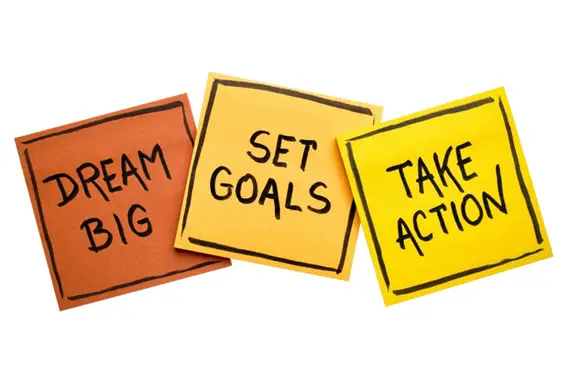As parents, one of our dreams for our children is for them to be successful and responsible. And what better way to start the road to success by teaching them important life skills like Goal setting
The good news is, studies show setting goals can be a game-changer! They can give you a big boost in motivation and actually help to change behaviours to reach for your dreams. It is also a very important life skill that makes a child more confident and more responsible.
Here are the 5 steps to help your child set effective short and long term goals.

1.Dream Big, Pick a Goal
"Setting goals is the first step in turning the invisible into the visible."
Tony Robbins
For your child to achieve a goal, you first need to explain what a goal is and how important it is to them.
Don’t force your goals on them. Help them discover what they truly want to achieve this year.
When the goal is something, they truly care about, they’ll be more motivated to reach it!
You can ask them questions like:
● What hobbies or skills would you want to learn or improve?
● What subject or topics do you find most interesting at school?
● What is something you wish you could achieve?
● Are there any areas you feel you could improve? ( e.g. Education, Communication)
● Was there a project or assignment at school that you enjoyed working on and what made it enjoyable?
Ensure to write these goals, this helps define exactly what you want to achieve
Bonus Tips: You can create a vision board.
This involves finding visuals that represent your goals. These visuals can be photos, or just text with illustrations. For example, a goal related to academics and maths could be represented by the phrase “Acing that maths test!” paired with a picture of a student confidently solving a complex equation on a whiteboard.
Then, print and cut out these visuals, stick them on cardboard, and hang them on a wall so that they can see them daily. This visualisation technique helps them stay focused on their goals.
Also, you can add some affirmations for kids, you can get some of that in our High Flyer Tool Box.

2. Help them make it SMART.

What is SMART?
- S – Specific: Make the goals focused and well defined.Instead of “get better at reading,” a specific goal might be “read for 20 minutes every night this week
- M – Measurable: Make a way on how the progress will be tracked. numbers help them see how far they’ve come. They can track pages read, minutes practised, or completed tasks.
- A – Achievable: Set a goal that’s challenging but reachable for your child’s age and skills.Starting small and building confidence is key.
- R – Relevant: Does this goal matter to your child? Their interest will fuel their motivation. Involve them in the goal-setting process!
- T – Time-bound:Set a deadline to create a sense of urgency and keep them on track. This could be a weekly, monthly, or even yearly-long goal.
3. Break it down
Instead of aiming straight for a big, long-term goal, you can help your child achieve it by taking small steps. Imagine a giant staircase – each step is a manageable chunk that will gradually lead them up to their big dream
Research named “The Power of Daily Goals by Heidi Grant Halvorson” suggests that focusing on daily goals, rather than just long-term ones, can be more effective for motivation and achievement that is breaking down large goals into smaller, manageable steps create a sense of progress and keeps individuals engaged in the process.
This helps your child stay motivated, continue improving and practicing the skills needed to reach their “big goal,” and gives them more opportunities to celebrate success along the way.
Bonus Tip: You can make this visual by creating a Goal ladder.
Draw a ladder with the big goal at the top. Write each smaller step on a rung of the ladder, creating a clear path to success. You can decorate it with drawings or stickers to make it extra fun!
This “Goal Ladder” will be a visual reminder of their progress and would keep them motivated as they climb towards their dreams!

4. Plan for Challenges
Reaching a goal is rarely a smooth journey. There will be bumps along the way, and moments where things get tough, or progress seems to stall. Don’t worry about that as it is perfectly normal! The key is to be prepared for these challenges and have a plan to tackle them.
Here’s a quick “Challenge Plan” to tackle setbacks:
Think Ahead: Take some time to think of some obstacles they might face on your way to achieving their goal. Also, think of distractions that might hinder their progress
Become a Problem Solver: As you have identified the problems create a way to avoid these challenges and reduce the distractions
Be their Support System: Always be there when they need to talk or have any issues achieving their goals. If you notice they are slipping or getting distracted from achieving their goals, be quick to ask them questions and set them back on track.
Bonus Tips: Have positive self-talk by talking positively about both yourself and your child. Teach statements like, “I can do this,” or, “I’m working hard to reach my goals.” Also, introduce the use of daily affirmations.
5. Monitor progress and don't forget to celebrate every step
The key to supporting your child’s goals is celebrating every step of the way. Acknowledge their hard work, and not just the final result. When they face setbacks, be their cheerleader, offering encouragement and helping them find solutions. Remember, it’s about the journey, not just the destination. By celebrating small wins and praising their effort, you build their resilience and keep them motivated to reach their goals.
Don’t Stop Climbing! Supporting Your Child’s Ongoing Success!
Congratulations! You’ve helped your child navigate the exciting (and sometimes bumpy!) path of setting goals. Remember that achieving goals is a journey, not a destination. By fostering their dreams, providing support, and celebrating their progress, you’re equipping them with valuable life skills that will benefit them for years to come.
Invest in your child’s future today!
Check out our amazing High Flyer Tool Book for Pre-teens and Teens.This interactive tool can help your child:
- Visualise their goals: With fun and engaging activities, which they can use to create a roadmap for success.
- Track their progress: Celebrate every milestone with interactive trackers and reward systems.
- Daily Affirmations: A compendium of powerful affirmations to help preteens and teens build self-esteem and create their desired future.
By combining these tips with the engaging features of High Flyer Tool Book for Pre-teens and Teens, you can create a powerful goal-setting experience that will set your child up for success! Get it here for your teenager and here for your child (ages 7-10 years).





